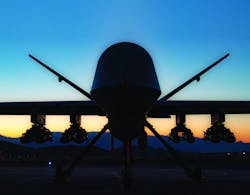NASHUA, N.H. - When commercial and military flightline crews ready equipment and pilots take to the skies, they want the sense of safety born out of rigorous testing of systems with trustworthy equipment. With modern flightline crews being asked to do more with fewer crew members on equipment packed with more technology than ever, reliable and accurate test and measurement has become even more vital.
Retired U.S. Air Force Maj. Gen. Stephen Sargeant, who is the CEO of Marvin Test Solutions in Irvine, Calif. says that robust test and measurement equipment, “is all about mission readiness, but frankly, that’s the key to being successful as a military, and it requires comprehensive and accurate testing of very complex systems that the warfighters rely on to accomplish their objectives across the target the first time, and that’s very, very important.”
Marvin Test’s Sargeant says that ensuring the munitions being carried onboard today’s military aircraft are sufficiently tested to hit their target keeps warfighters on the move and in less danger.
“So, they don’t have to go back a second time if things don’t work properly. That just ups the odds that things don’t go well for the people involved either on the ground that or our folks are flying in support of those folks that are flying across the target a second or third unnecessary time because things didn’t work the first time,” Sargeant says. “So, it’s very important that we send people into battle with fully tested equipment that is fully mission capable.”
He continues, “So you need the very accurate, comprehensive test equipment to check out that aircraft and its systems, and then over time, precision guided munitions have really become the weapon of choice for militaries around the world ... They’ve got much more electronics both on board and on and off for guidance, which makes the testing much more complex. And so, the test sets have to be up to the challenge of today’s weapons.”
Eyes on cost
Test and measurement can bring monumental expenses to getting an aircraft into service in civilian and military capabilities, says Patrick Quinn, senior product line manager for data acquisition at Curtiss-Wright Corp. based in Davidson, N.C.
“Flight test is a very expensive process,” Quinn says. “So, the more and more flights you have to do, the more expensive it is. So, you’re unsure of your results if you have to repeat tests at longer times. You want to be sure to minimize interference like that — your equipment is gathering the data correctly, and you need confidence in your equipment.”
Accuracy in test equipment is one major component in minimizing flight test time, says Farhad Daghigh, also of Curtiss-Wright, who is the company’s vice president of sales in aerospace instrumentation.
“There is one other factor that we should also mention that makes it different than a lot of other testing in general that taking place in this country — but what’s crucial about flight testing is the timing of having a fully synchronized data system that’s accurate within not just microseconds in the latest technology or in the latest offerings that we’re providing to our customers,” Daghigh says. “Having a nanosecond accuracy and synchronized data is very important, because if a specific event happens, let’s say in an unlikely event that the wing splits open, they want to know based on thousands of measurements what exactly happened at that instant in time.
He continues, “What [happened] when they did this very hard banking that created a rupture in the skin or the structural integrity of that specific aircraft. Another very important aspect of that is when you’re looking at the data during a test flight, you want to make sure that you’ve successfully completed each of your tests, your test operations in particular, a maneuver like thank you for certain degree or something like that is what you’re looking for.”
While Daghigh says flight test equipment is invaluable in the commercial and military aviation sectors, the latter has additional stresses that need to be considered when choosing test equipment.
“Military aircraft have to go faster — commercial aircraft don’t go to the sound barrier,” says Curtiss-Wright’s Daghigh. “The equipment we provide has to withstand that type of environment. It’s very challenging to make sure it can survive that environment and provide that high-temp solution that can withstand a lot more rigorous environment that a commercial aircraft will.”
High-speed data
With blazing-fast systems enabling the most technology-packed aircraft yet, Ben Kupferschmidt, senior manager of desktop software at Curtiss-Wright Corp., saysthat transmission of data from the sky to the ground is more important than ever.
“So, one of the biggest trends is that end users are collecting more data than they ever have in the past and the data they’re collecting is running at higher speeds,” Kupferschmidt says. “They’re collecting more data ... quicker. So, you’re getting exponentially more data than you did in the past. And that creates a number of challenges because that means you have to continue your transmission. Bandwidth from the aircraft to the ground is relatively limited. You know, there there’s not that much bandwidth that’s allocated to flight test.”
Kupferschmidt says that because so much data is collected, it is easy to isolate it very specific parameters.
“Show me all the maneuvers — a certain type when the speed was greater than 500 miles-per-hour and the altitude was greater than 10,000 feet,” Kupferschmidt says. “And you can then show you all the data that matches that criteria and that would allow you to find things you want to analyze in more detail very quickly.”
Proactive and reactive
While having a massive amount of data can be fantastic, Marvin Test’s Sargeant says that it also can be a risk. “Now what’s happening is all this data is coming in and people are realizing there’s a liability with having that much data,” Sargeant says. “And especially some of that data is being stored in the cloud and that brings cyber security right to the forefront. We need to secure this data so it cannot be used maliciously. And so cyber security features are being mandated to be brought forward with any test systems that are going to be connected to the airplane, to the armament or to the weapons.”
Sargeant continues, “There’s a massive amount of data that is collected every day when tests are run. In the past it just wasn’t used unless there was a problem; somebody might go back and look at it. Now it’s going to be used a lot because there’s the drive toward predictive maintenance which could lower costs. And that is something very, very attractive across the board.”
By analyzing data, Sargeant says the lifespan of components can be monitored and replaced before they become a liability to mission readiness.
“Maybe the engine that will drive from reactive maintenance of fixing things when they break or preventive maintenance fix it when there’s a scheduled course based on historical data, which may or may not actually be right for the part you’re fixing. We’re going to go with that, because that’s ... predictive maintenance.”
He continues, “And it won’t typically be a specific point, but it will be a range. And now you can you can make the risk assessment and change that part, which always costs money in terms of time and actual funding of the pieces and parts of aircraft. Then you can actually reduce the cost by having that level of analytics brought into the test the measurement world. There’s a huge push toward that.”
Checking components
Marvin’s Sargeant explains that line-replaceable technology components need to be tested before they make it into the fleet.
“The reality is, all military electronics — whether it’s circuit cards, subassemblies, line replaceable units — they all require a certain amount of functional test toshow that they’re operating properly before being issued out to the fleet.”
Sargeant says that customers are asking for test and measurement technologies that can do multiple functions across different aircraft.
“Even during COVID, the move toward smaller, rugged, and multi-capable test technology is definitely happening because it’s being funded in many ways,” Sargeant says. “So, the other thing that we see there is not only do they want to see maintenance and sustainment activities to be able to be accomplished faster, but with fewer people, and they want that same test equipment to be used across a multitude of aircraft.”
On the line
This fall, Military & Aerospace Electronics recognized Marvin Test Solutions as a platinum-level winner in its 2020 Innovators Awards for its Marvin Test-3060A SmartCan Gen2 universal O-level aircraft armament test set.
The Marvin Test-3060A SmartCan Universal O-Level Armament Test Set from Marvin Test Solutions Inc. addresses the challenges of performing flightline test activities with an existing generation of armament test sets that limit the ability to verify armament system functionality, failures, and readiness.
The system can perform flightline test and measurement of all fighter aircraft armament and gun systems. The SmartCan weighs 4.2 pounds, and incorporates more than 30 measurement channels, electronic loads, communications interfaces, a switch matrix, and video/audio signal generators, and cable ID.
The test set for combat aircraft uses the Marvin Test Solutions ATEasy test executive and test development software.
Today’s flightline armament maintainer faces the challenging task of performing O-Level flightline activities with an existing legacy generation of armament test sets that greatly limit the ability to verify armament systems.

Jamie Whitney
Jamie Whitney joined the staff of Military & Aerospace Electronics and Intelligent Aerospace. He brings seven years of print newspaper experience to the aerospace and defense electronics industry.
Whitney oversees editorial content for the Intelligent Aerospace Website, as well as produce news and features for Military & Aerospace Electronics, attend industry events, produce Webcasts, oversee print production of Military & Aerospace Electronics, and expand the Intelligent Aerospace and Military & Aerospace Electronics franchises with new and innovative content.




